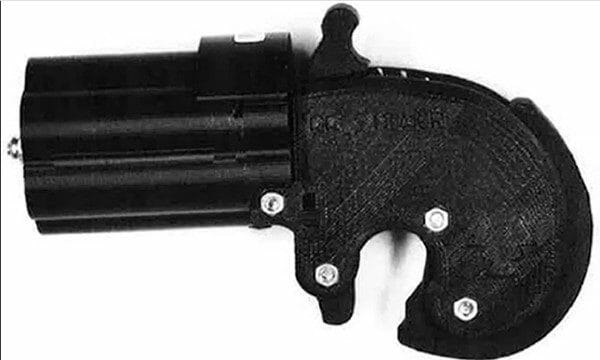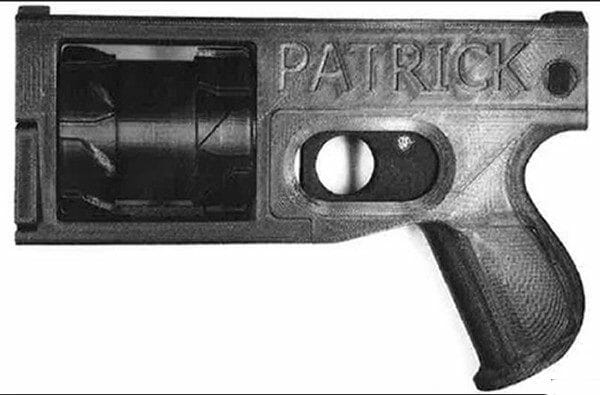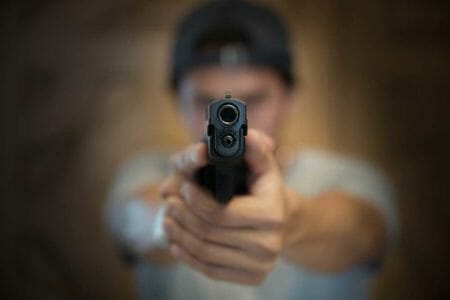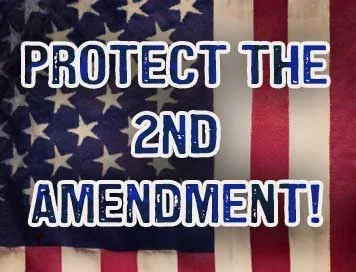
London, U.K. -(Ammoland.com)- A young man from Zimbabwe has been convicted in London of making and possessing two guns with a 3D printer. The gun parts were discovered during a raid searching for marijuana. From independent.co.uk:
A second raid of his home in February 2018 led to the discovery of further components of another 3D printed gun.
Acting Detective Sergeant Jonathan Roberts, who led the investigation, said: “We know that Muswere was planning to line the printed firearms with steel tubes in order to make a barrel capable of firing.
“This conviction, which I believe is the first of its kind relating to the use of a 3D printer to produce a firearm, has prevented a viable gun from getting into the hand of criminals.”
The design at the top appears to be a six shot version of the reprringer 3x pepperbox. The reprringer is a manually indexed, single action pepperbox. The cylinder has to be turned and indexed manually, and the hammer cocked, for each shot.
People have been convicted in Australia of making 3D printed guns. The laws are more restrictive in Australia, where it is illegal to possess a replica without a license, or to possess the computer instructions on how to print out gun parts with a 3D printer. This is the first time a person has been convicted of making and having a 3D printed gun in England.
Both of these designs are composite designs. They use easily obtainable metal shapes to contain the pressure of firearm cartridges, primarily for the barrel. The 3D printer makes it easier to create the fire control mechanism for multiple shots.
Both of the firearms designs showed by the Metropolitan Police fall under the classification of pepperboxes. Pepperboxes are some of the simplest revolvers. They use multiple barrels, rotating about a central axis. They were produced as flintlock, become more reliable with percussion caps, and most reliable with self contained cartridges.

The Washbear PM522 is an eight shot, double action pepperbox revolver. Pulling the trigger rotates and indexes the cylinder, cocks and releases the striker to fire the pistol. It is a bit more complex and bulkier pistol than the Reprringer. Both designs have been fired on youtube videos.
The simplicity of the design lends itself well to a composite 3D printed, multishot pistol.
In London, the designs did not have steel tubes inserted as barrel liners. The Police claim Mr. Muswere was planning to obtain and insert the steel barrel liners.
Where ammunition is tightly regulated, the designs are easily adapted to what ammunition is available, or to simple ammunition substitutes that are commercially available over the counter.
Common .22 rimfire ammunition is the usual caliber used. One advantage is very low powered loads are available. As .22 rimfire is almost never reloaded, controls are less rigorous than for other cartridges. .22 rimfire is ubiquitous and commonly used for hunting and pest control in .22 rifles. It may be the most easily available ammunition in most underground markets.
The other substitute, commonly available and used in China, is the powered bolt driver rounds, such as Ramset copies. Manufacturers of such items caution they should not be used in firearms.
The powder charges are different, but the priming system and machines used to make them are the same as for .22 rimfire. A projectile needs to be added to make them into useful ammunition. It need not be attached to the cartridge. Examples are commonly found where the projectile is glued to the bolt or nail driver round. Projectiles may be loaded separately. I have been told the nail gun type cartridges use an extremely fast powder, which can create high chamber pressures.
A feature which would make the 3D printed composite pepperbox designs more durable and reliable would be a metal base plate at the rear of the barrels. It would need holes or slots for the firing pin, a threaded hole for the cylinder pin, or a simple hole for the cylinder pin with a threaded nut on the other side. This would strengthen the design considerably.
Add another, smaller metal plate at the front, with a hole for the cylinder pin, that overlaps the steel barrels without obstructing them, and you have created a system that uses metal to contain the forces of the cartridge firing.
The entire cylinder assembly, with cylinder pin and plates, could be made as an easily replaceable unit. People who desired quick reloads with the Colt percussion revolvers often carried extra cylinders.
The 3D printed components would be used to align the barrels properly for firing and to create the fire control system of hammer and trigger and other parts used to rotate and index the cylinder.
Guns are a 14th-15th-century technology. Homemade guns and small shop guns are found all around the world. In the United States, it has been the right of the people to make their own guns for the entire history of the Republic. Only in the last few years has the right been challenged.
There are so many unregistered and untraceable guns in the United States that the right to make your own has relatively little effect.
Its primary utility is to convince the uneducated of the futility of gun control schemes.
3D printed guns seem to do that more effectively than most other homemade guns.
About Dean Weingarten:
Dean Weingarten has been a peace officer, a military officer, was on the University of Wisconsin Pistol Team for four years, and was first certified to teach firearms safety in 1973. He taught the Arizona concealed carry course for fifteen years until the goal of constitutional carry was attained. He has degrees in meteorology and mining engineering, and recently retired from the Department of Defense after a 30 year career in Army Research, Development, Testing, and Evaluation.








I can testify to the power of nail gun blanks,ive seen them used in cylinders for cap and ball revolvers and they can hurl .375 or .457 round balls over 850fps. The loads are labeled remington and most construction stores sell the 22cal under $10 a 100.yellow power level 4..27s are a bit higher but more powerful.
I like it, nice little belly gun to keep the rats off of you in a bad place at least having six rounds to shoot.
You wouldn’t think it would be to hard to line the barrels with machined steel if you only make it for 22
cal. Wonder if that 3-d printer will ever be offered on here again? It would be nice to have options.
The Police State will never succeed in stopping determined individuals from creating contraband objects, assemblies, chemicals, and other items from materials found in nature and modern society. A hardare store and grocery store, and scrapyard contains all the materials needed to create a knife, firearm, explosive, and pyrotechnic. Add knowledge, and common hand tools and a determined person can create such devices. Power tools make the job easier, but hand tools are sufficient. The Internet is a grand source of information, plans, and guides on making most everything. The Wayback Machine contains a wealth of information on weapons and materials… Read more »
One could also adapt the design to cap and ball. Black Powder is trivial to make (Sulfur is essential for agriculture so it can’t be regulated, charcoal is likewise impossible to regulate, and saltpeter can be obtained from urine) and I understand corosive primers aren’t that much harder.